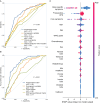Risk factors, predictive models, and general work ability trajectory in patients with glioma
- PMID: 40575407
- PMCID: PMC12202001
- DOI: 10.1093/noajnl/vdaf094
Risk factors, predictive models, and general work ability trajectory in patients with glioma
Abstract
Background: Glioma research has increasingly emphasized quality of life alongside traditional survival metrics, emphasizing functional outcomes, symptom burden, and social reintegration, including the ability to work. While previous studies focused on return-to-work rates, we assessed general work ability as a broader measure of work capacity. We aimed to develop predictive models for general work ability recovery, identify key risk factors, and explore long-term trajectories.
Methods: We conducted a retrospective cohort study of 342 patients with glioma (aged 18-64, WHO Grades 2-4) between March 2010 and December 2018. Work ability and symptoms were assessed using the M.D. Anderson Symptom Inventory-Brain Tumor Module (MDASI-BT), which was administered at months 1 and 3 postoperatively, then every three months up to 12 months, and at longer intervals thereafter. Logistic regression predicted 6-month general work ability recovery, and Cox models identified long-term risk factors. Long-term monitoring was conducted to evaluate the stability of work ability recovery across different WHO grades.
Results: 65.2% (223/342) regaining general work ability within 6 months post-surgery. Brain tumor-specific symptoms were stronger predictors of recovery than general symptoms. Predictive models achieved AUCs of 0.78 (pre-surgery) and 0.82 (post-surgery). Long-term monitoring showed recovery instability, with cumulative recovery rates for WHO Grades 2-4 at 82.1%, 50.8%, and 28.2%, respectively, while peaks at 50.8%, 28.3%, and 7.3%.
Conclusions: Brain tumor-specific symptoms significantly impact general work ability recovery. Recovery instability was observed across all patients, underscoring the importance of targeted symptom management, personalized care, and sustained follow-up to improve quality of life.
Keywords: glioma; risk factors; work.
© The Author(s) 2025. Published by Oxford University Press, the Society for Neuro-Oncology and the European Association of Neuro-Oncology.
Figures




Similar articles
-
Systemic pharmacological treatments for chronic plaque psoriasis: a network meta-analysis.Cochrane Database Syst Rev. 2021 Apr 19;4(4):CD011535. doi: 10.1002/14651858.CD011535.pub4. Cochrane Database Syst Rev. 2021. Update in: Cochrane Database Syst Rev. 2022 May 23;5:CD011535. doi: 10.1002/14651858.CD011535.pub5. PMID: 33871055 Free PMC article. Updated.
-
Systemic pharmacological treatments for chronic plaque psoriasis: a network meta-analysis.Cochrane Database Syst Rev. 2017 Dec 22;12(12):CD011535. doi: 10.1002/14651858.CD011535.pub2. Cochrane Database Syst Rev. 2017. Update in: Cochrane Database Syst Rev. 2020 Jan 9;1:CD011535. doi: 10.1002/14651858.CD011535.pub3. PMID: 29271481 Free PMC article. Updated.
-
Drugs for preventing postoperative nausea and vomiting in adults after general anaesthesia: a network meta-analysis.Cochrane Database Syst Rev. 2020 Oct 19;10(10):CD012859. doi: 10.1002/14651858.CD012859.pub2. Cochrane Database Syst Rev. 2020. PMID: 33075160 Free PMC article.
-
Computer and mobile technology interventions for self-management in chronic obstructive pulmonary disease.Cochrane Database Syst Rev. 2017 May 23;5(5):CD011425. doi: 10.1002/14651858.CD011425.pub2. Cochrane Database Syst Rev. 2017. PMID: 28535331 Free PMC article.
-
Nutritional interventions for survivors of childhood cancer.Cochrane Database Syst Rev. 2016 Aug 22;2016(8):CD009678. doi: 10.1002/14651858.CD009678.pub2. Cochrane Database Syst Rev. 2016. PMID: 27545902 Free PMC article.
References
-
- Di Perri D, Jmil S, Lawson TM, et al. Health-related quality of life and cognitive failures in patients with lower-grade gliomas treated with radiotherapy. Cancer Radiother. 2023;27(3):219–224. - PubMed
LinkOut - more resources
Full Text Sources
